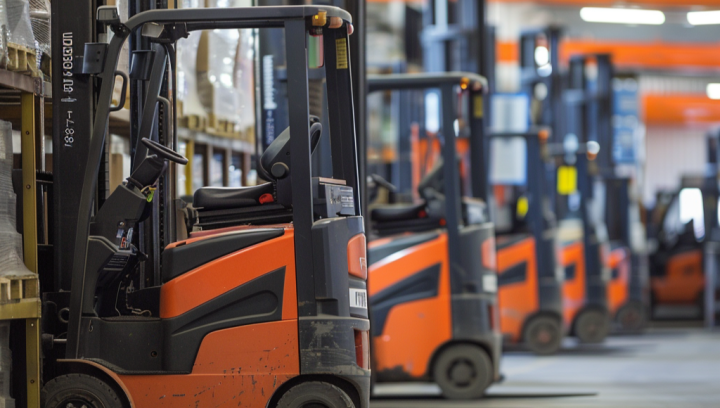Types of Forklifts
There are several types of forklifts, each designed for specific tasks and environments:
- Counterbalance Forklifts: The most common type, with forks at the front and a weight at the back to balance the load. Ideal for general warehouse use.
- Reach Trucks: Designed for narrow aisles and high stacking, with extended reach capabilities.
- Pallet Jacks: Manual or electric, used for moving pallets in tight spaces and for short distances.
- Telehandlers: Equipped with a telescopic boom, allowing for greater reach and height. Commonly used in construction.
- Order Pickers: Used in warehouses for picking and transporting individual items from racks.
- Rough Terrain Forklifts: Built for outdoor use on uneven surfaces, often used in construction sites and lumber yards.
- Side Loaders: Ideal for handling long, bulky loads like timber and pipes, allowing for side loading and unloading.
Benefits of Forklifts
- Increased Efficiency: Forklifts can move heavy loads quickly and efficiently, reducing the time and labor required for material handling.
- Improved Safety: Properly used forklifts reduce the risk of injuries associated with manual lifting and moving heavy objects.
- Versatility: Various types of forklifts are available to handle different materials and operate in diverse environments.
- Enhanced Productivity: Forklifts enable faster loading and unloading, improving overall productivity in warehouses and manufacturing facilities.
Choosing the Right Forklift
Selecting the right forklift involves considering several factors:
- Load Capacity: Determine the maximum weight the forklift will need to lift and choose a model with the appropriate load capacity.
- Lift Height: Consider the maximum height you need to lift materials and select a forklift that meets these requirements.
- Environment: Assess whether the forklift will be used indoors, outdoors, or both. Rough terrain forklifts are suitable for outdoor use, while electric forklifts are ideal for indoor use due to their lower emissions.
- Fuel Type: Forklifts can be powered by gasoline, diesel, propane, or electricity. Electric forklifts are quieter and emit no exhaust fumes, making them suitable for indoor use.
- Maneuverability: For tight spaces and narrow aisles, choose a forklift with good maneuverability, such as a reach truck or an order picker.
- Attachments: Depending on your needs, you may require specific attachments like clamps, side shifters, or rotators to enhance the forklift’s functionality.
Safety Practices for Forklift Operation
Safety is paramount when operating forklifts. Follow these practices to ensure safe operation:
- Training: Ensure all operators are properly trained and certified to use forklifts.
- Inspections: Conduct daily inspections of the forklift to check for any mechanical issues, such as faulty brakes or worn tires.
- Load Handling: Never exceed the forklift’s load capacity and ensure loads are balanced and secured before lifting.
- Speed Limits: Adhere to speed limits and drive cautiously, especially in congested areas.
- Visibility: Maintain clear visibility at all times. Use mirrors and backup alarms to increase awareness of surroundings.
- Parking: Always park the forklift in a designated area, with the forks lowered to the ground and the engine turned off.
Maintenance Tips for Forklifts
Regular maintenance is crucial for the longevity and safe operation of forklifts:
- Routine Checks: Perform routine checks on the hydraulic system, brakes, tires, and other critical components.
- Fluid Levels: Regularly check and top up fluids such as oil, coolant, and hydraulic fluid.
- Battery Maintenance: For electric forklifts, ensure the battery is charged correctly and kept clean.
- Scheduled Servicing: Follow the manufacturer’s guidelines for scheduled servicing and part replacements.
- Cleanliness: Keep the forklift clean to prevent dust and debris from causing mechanical issues.
Conclusion
Forklifts are indispensable tools in various industries, offering efficiency, versatility, and improved safety for material handling tasks. By understanding the different types of forklifts and considering factors such as load capacity, environment, and safety practices, you can select the right forklift for your needs. Regular maintenance and proper operator training are essential to ensure the longevity and safe operation of your forklift.
